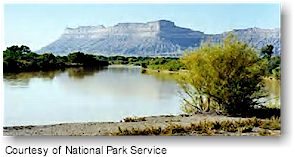|
 There was money to be made in transporting New Mexico serapes and other woolen goods to Los Angeles, and in wrangling California-bred horses and mules back to Santa Fe. But a viable overland route across the remote deserts and mountains of Mexico’s far northern frontier had to be found. There was money to be made in transporting New Mexico serapes and other woolen goods to Los Angeles, and in wrangling California-bred horses and mules back to Santa Fe. But a viable overland route across the remote deserts and mountains of Mexico’s far northern frontier had to be found.
It took the vision and courage of Mexican trader Antonio Armijo to lead the first commercial caravan from
Abiquiú, New Mexico, to Los Angeles late in 1829. Over the next 20 years, Mexican and American traders continued to ply variants of the route that Armijo pioneered, frequently trading with Indian tribes along the way. And it was from a combination of the indigenous footpaths, early trade and exploration routes, and horse and mule routes that a trail network known collectively as the Old Spanish Trail evolved.
Santa Fe emerged as the hub of the overland continental trade network linking Mexico and United States markets—a network that included not only the Old Spanish Trail, but also the
Santa Fe Trail and
El Camino Real de Tierra Adentro. After the United States took control of the Southwest in 1848 other routes to California emerged, and use of the Old Spanish Trail sharply declined.
Because of its rich history and national significance, the Old Spanish Trail has been designated as a national historic trail. The Bureau of Land Management and the National Park Service are currently working with the
Old Spanish Trail Association and a variety of federal, state, and local agencies, non-profit organizations, landowners, and tribal entities, to develop a draft Comprehensive Management Plan and Environmental Impact Statement. Once planning is completed, the two agencies will jointly administer the national historic trail, which is more than 2,700 miles in length and crosses New Mexico, Colorado, Arizona, Utah, Nevada, and California.
Getting There:
The Old Spanish Trail Association
offers a map which illustrates the many separate routes that developed through time as traders opened commerce joining New Mexican merchants, Rocky Mountain and Mojave Desert peoples, and the rancheros of coastal California.
|



